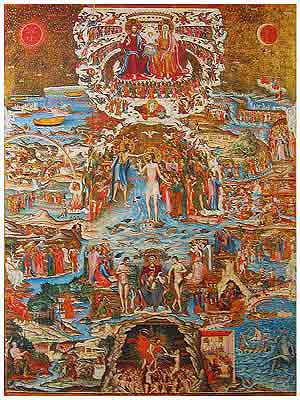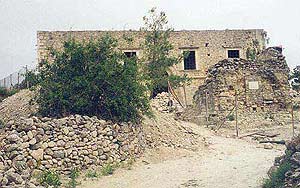The icon painter Ioannis Kornaros


|
Sights - Lassithi Prefecture |
||
|
Toplou Monastery |
|
The icon Megas ei Kyrie |
|||
The icon painter Ioannis Kornaros |
|
| Ioannis
Kornaros lived from 1745 to 1796. Unfortunately not much is known about
his life. But from a manuscript of the icon painter Stefanos Nikola´dis
(1817-1907), we know that Kornaros worked in Crete and Cyprus plus in
Sinai and perhaps also in Egypt.
|
|
| In
Crete he started his life as a painter at the Savvathiana monastery
outside the village of Rogdia a little west of Iraklion. There he painted
an icon by the name of "Megas ei Kyrie" (Great
Art Thou, O Lord), a forerunner of the final version, which he later
finished in Toplou. The original icon still existed in 1854, where Nikola´dis
saw it, although half ruined by moist. Unfortunately it has since been
ruined completely. Besides painting in the two monasteries, Kornaros
painted in the Agios Matthaios ton Sina´ton church in Iraklion.
|
|
| In
the period 1775-1790 we find Kornaros in Sinai, where he both painted his
own icons and restored others' plus he contributed to the decoration of
the church ceiling in the Agia Aikaterini monastery. Icons from this
period also exist in Egypt, but it is uncertain if he has in fact been
there himself.
|
|
|
After
his stay in Sinai Kornaros went on to Cyprus, were he among other things
painted the "Archangel Michael" in 1795. Today it can be seen in
the Byzantine Museum in Athens.
|
|
|
|
|
| The icon Megas ei Kyrie (Great Art Thou, O Lord) |
|
|
|
|
| As
mentioned before, you find in Toplou - in addition to his icon "Agia
Anastasia in Farmakolytria" - also the "Megas ei Kyrie"
from 1770. The name of it derives from the prayer to The Great
Sanctification of the Water written by Sophronius the Jerusalemite
Patriarch, which begins with exactly these words.
|
|
| The
icon, which is painted on wood and has the dimensions 1,33 X 0,85 m, has
an inscription at the bottom to the left saying, who the painter was, when
it was painted, and who paid for it:
|
|
| A work by Ioannis Kornaros at the age of 25 years with the help of the Lord's | |
| very most pious Mr Parthenios, monk and abbot, secularly called Kafouros, in the | |
| fifth year of his abbey | |
|
1770.
|
|
| To
the right there is another inscription:
|
|
|
|
|
| The
icon belongs to the category of icons, which depict many persons. These
are often painted separated from each other. But on "Megas ei
Kyrie" all the motifs are rather woven into each other and at the
most separated by the water streams, which are the general element of the
icon. Even though there are icons that resemble Kornaros' (for example in
the Benaki Museum in Athens and in the Tretjaskov Collection in Moscow) it
is still unique by - around the four central motifs - depicting the
various scenes mentioned in the prayer. That Kornaros is the first to
depict The Great Sanctification of the Water makes it interesting too.
|
|
|
|
|
| Description of the icon. | |
|
|
|
| The
icon consists of 61 selected scenes from the Old and the New Testament.
The four central motifs described in the icon are from the top The Holy
Trinity surrounded and praised by the heavenly flocks (Gloria). Under this
follow the baptism of Jesus, the Virgin Maria with the Infant Jesus
encircled by Adam and Eve, and at the bottom is Jesus' arrival to the land
of the dead. To the left and the right of these motifs are scenes from the
Old and the New Testament. The central theme of the icon becomes in this
way the baptism itself - at the top encircled by the heavenly and at the
bottom by the earthly. It is exactly consistent with the prayer "Megas
ei Kyrie", which belongs to the group of prayers with relations to
the religious celebration Theofaneia (also called Epifaneia or Fota) on
the 6th of January and celebrating the baptism of Jesus in the Jordan
river and the appearance of The Holy Trinity during the baptism.
|
|
| Kornaros'
way of painting follows the Byzantine tradition with loans from the West,
which is also known from for example Michail Damaskinos, Theofanis, Emm.
Tzanes, Theodoros Poulakis and other Cretan icon painters from the 16th
and 17th century. Is has to be remembered that Crete at that time was
subjugated Venice, and that Kornaros derived from a Venetian-Cretan family.
The depiction of The Holy Trinity, the angels around this, the baptism,
the arrival to the land of the dead and many of the smaller depictions are
loans from earlier painters (not least from Georgios Kastrofylakas, who to
all appearances was his teacher) and not Kornaros' own, but he alone must
be given the credit for the working out and the composition of these loans
in an incredibly beautiful way. It is also his work to insert lines from
the prayer "Megas ei Kyrie" next to the particular motifs.
|
|
| The
icon is also remarkable by depicting themes, which are not sanctioned by
the Orthodox Church. The zodiac is normally not seen in church paintings,
and the icon also personifies the four elements of nature.
|
|
|
|
|
| Families Kornaros and Metzos | |
|
|
|
| Two
big and rich families - Kornaros and Metzos (DeMezzo) - lived in the
eastern Crete during the Venetian Period. Both families derived from
Venice, but in the course of time they became completely assimilated in
Crete.
|
|
|
|
|
|
|
|
| The
Kornaros family had possessions in large parts of Crete. In a document
drawn up by Sitia's notary in 1581 is written that an inhabitant of the
village of Skopi by the name of Marinos
is selling and handing over a piece of land situated in Piskokefalo to the
noble Mrs Zampia, princess after the noble prince monsieur Giacomo
Kornaros. Zampia who was a daughter of Ioannis Metzos, was the mother
of Andreas and Vitzentzos Kornaros (the poet of the great medieval work
Erotokritos). In a document from 1582 the son Andreas Kornaros hands over
to his cousin Cornarola F. Kornaros a part of the village of Thrapsano. In
his will from 1611 is written that he makes his brother Vitzentzos the
heir of his luxurious house, his big book collection and his village
Thrapsano. If Vitzentzos is not alive, the inheritance is to be passed on
to his niece Caterusa.
|
|
| According
to the Crete-researcher Stelios Spanakis, the grave of the Kornaros family
is at the Agios Georgios church in the village of Paraspori, but I did not
succeed in finding it.
|
|